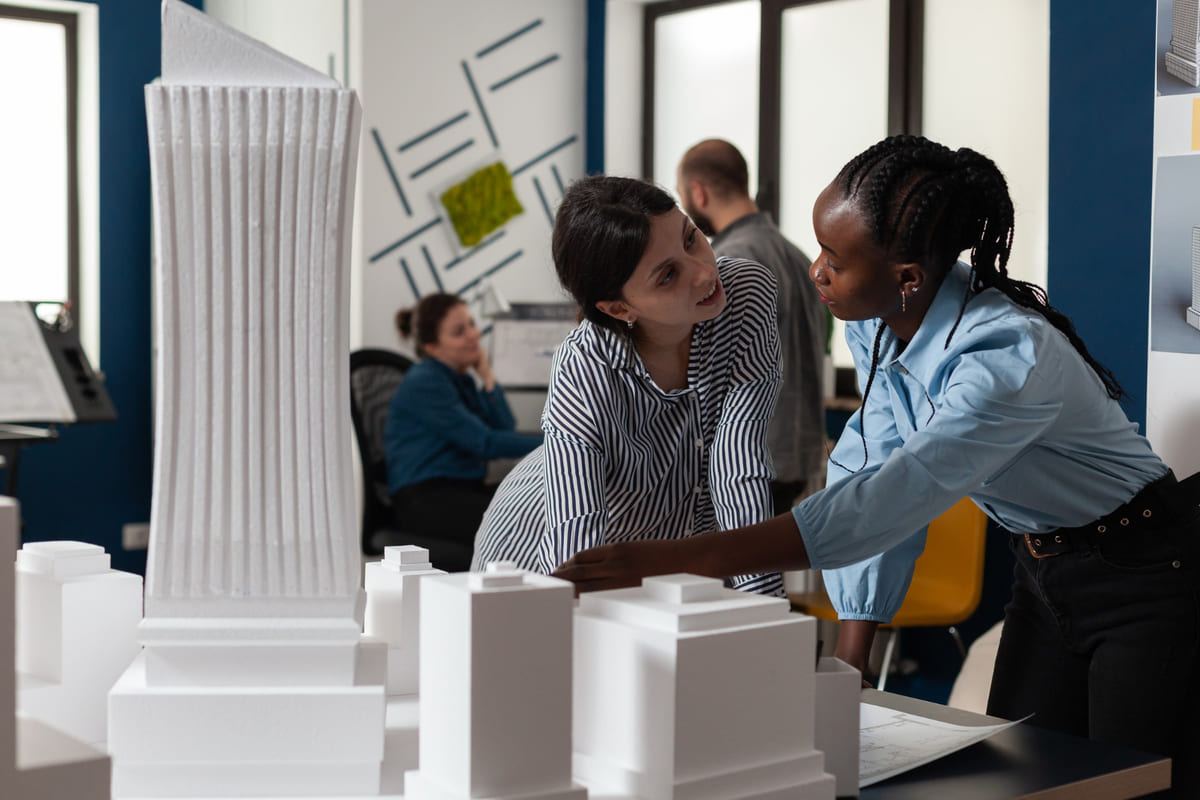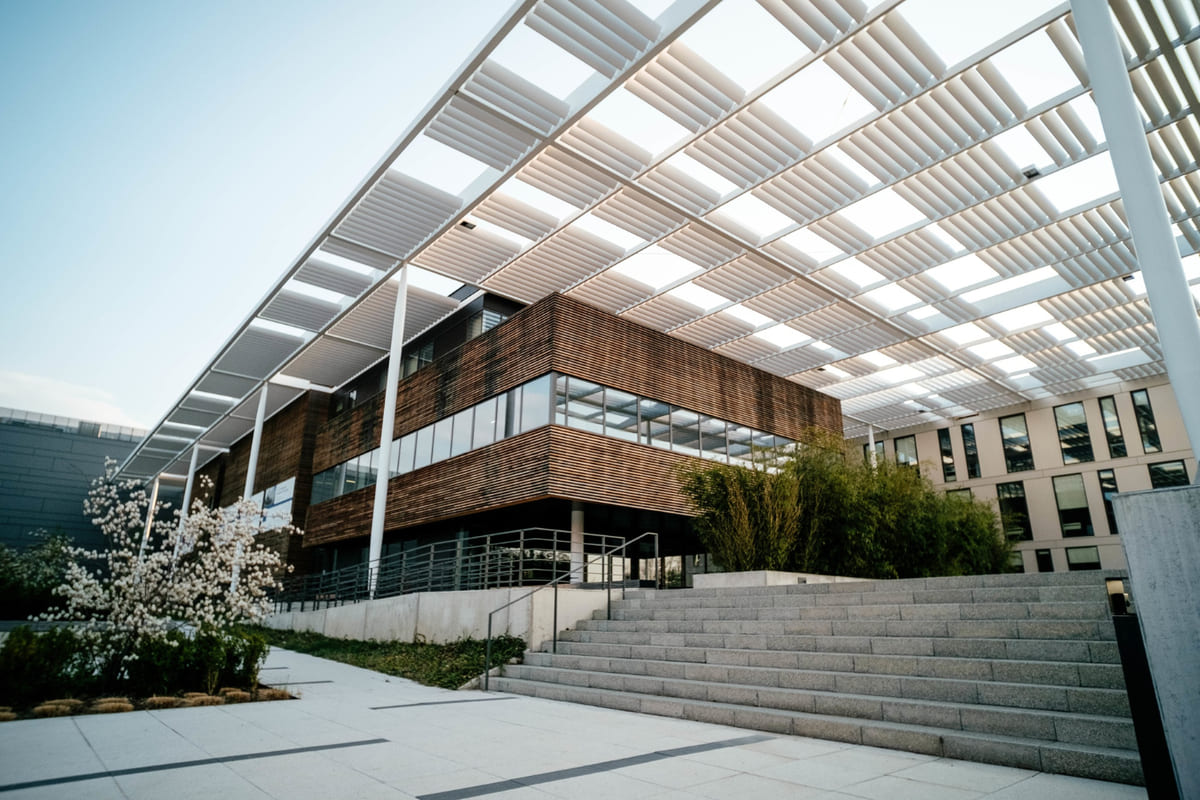Modern architecture education has rapidly evolved in response to climate urgency and digital innovation. By 2025, architecture curricula are increasingly centered on sustainability and cutting-edge technology. Students now use immersive tools like virtual reality (VR) and augmented reality (AR) alongside traditional studio methods, reflecting a shift from hand drafting to data-driven design.
Institutions such as Architecture 2030 highlight that “to incite design change we must begin at [the] source: architectural education,” noting that the built environment is responsible for roughly 39% of global CO₂ emissions and 70% of electricity use. Surveys confirm this momentum: in Australia and New Zealand, 95% of architecture students and faculty agreed that architects can be part of the climate solution and want more sustainability content in their degrees.
In practice, leading schools are integrating net-zero design, adaptive reuse, passive systems (like bioclimatic design and natural ventilation), and life-cycle thinking into studio projects. At the same time, advanced computational tools have become indispensable. For example, students now routinely learn BIM (Building Information Modeling) tools, parametric modeling, and even generative AI as part of core design studios. This synergy of environmental ethics and smart technology is the hallmark of Architecture University programs in 2025.
Table of Contents
Core Shifts in Architecture University Programs
1. Emphasis on Sustainability and Environmental Ethics
Architecture schools worldwide are dramatically deepening their focus on sustainable design principles. Where older curricula treated environmental concerns as optional, today many programs weave them into every year of study. Schools now offer dedicated courses on green materials, energy-efficient design, renewable energy systems, water conservation, and sustainable urban planning. Studio projects routinely require net-zero or low-carbon goals and often address social resilience (for example, disaster-adapted housing or community-driven regeneration). Sustainable design strategies like passive solar orientation, high-performance insulation, bioclimatic form-finding, daylight optimization, green roofs and facades are explicitly taught and critiqued in design studios. Educators report that students are deeply concerned about climate change and eager to learn zero-carbon techniques
.In fact, accreditation bodies and industry alliances are pressing for rapid curriculum change: one commentary notes that RIBA (Royal Institute of British Architects) is rethinking its criteria to train architects to be “leaders … on zero carbon,” addressing the “sad indictment” that zero-carbon training has been too thin and slow to appear. This has prompted programs to adopt climate ethics as a core competency – from lifecycle analysis of materials to designing for climate resilience – ensuring graduates can create buildings that are ecologically responsible and resource-efficient across their full lifecycle.
2. Integration of Digital Technologies in Design Studios
Contemporary architecture studios are no longer pencil-and-paper workshops; digital tools dominate the design process. Today’s Architecture University curricula mandate proficiency in software like Autodesk Revit (BIM), Rhinoceros + Grasshopper (parametric modeling), SketchUp, and others.
Universities equip students with VR headsets, AR toolkits, and collaborative design platforms so they can visualize designs immersively and explore spatial concepts in 3D. For example, VR modules let students “walk through their designs in a real-world setting,” yielding a more concrete grasp of form and space. Similarly, game engines (Unity, Unreal Engine) are being used for real-time rendering and interactive walkthroughs. Collaborative cloud platforms (BIM 360, Trimble Connect, etc.) enable global teamwork on a single building model.
Digital fabrication has also entered the curriculum: many schools have maker labs with CNC mills, 3D printers, and robotic arms, allowing students to take parametric models directly to physical prototypes. In sum, it is “no longer possible to imagine an architectural education curriculum that does not include the use of digital tools”. Courses explicitly teach these technologies so that graduates are fluent in industry-standard workflows and can quickly turn computational ideas into built form.
Suggested article to read: Top 7 Robotic Welding and Fabrication Types in Construction (2024)

3. Interdisciplinary and Data-Driven Approaches
Architecture University programs are breaking traditional silos. Students now collaborate across disciplines — integrating engineering, computer science, urban planning, and even data analytics — to tackle complex building and city challenges. For instance, some schools have joint architecture-computer science courses where students use programming and big data to optimize building performance.
Faculties encourage climate science, sociology, and economics electives alongside design studios, reflecting the reality that buildings impact social and environmental systems. A recent article emphasizes that curricula must adopt a “flexible, interdisciplinary approach where architecture is fused with subjects like computer science and data analytics,” highlighting the increasing role of AI in contemporary design.
In practice, this means students learn to use data-rich design processes: for example, machine-learning algorithms might inform urban shading studies or optimize energy use, and GIS (geographic information systems) tools may analyze site climate data. By making decisions based on environmental data and performance metrics, future architects develop “data-based design” mindsets that enhance building efficiency and sustainability.
Programs also incorporate real-world research strengths (e.g. climate adaptation, social equity, health) into studio projects, ensuring learning is grounded in addressing actual community and environmental needs. This interdisciplinary, evidence-based pedagogy gives graduates a broad toolkit: they not only design beautiful forms but also use data and teamwork to make those forms function sustainably and equitably.
Leading Architecture University Programs Embracing Change
1. North America
In the United States and Canada, many top architecture schools lead with sustainability and tech. For example, MIT’s School of Architecture and Planning integrates environmental responsibility into its famous urbanism and digital fabrication programs.
Harvard’s Graduate School of Design emphasizes cross-disciplinary research and has explicitly committed to educating “leaders in design” who will create a “resilient, just, and beautiful world.” Universities like UC Berkeley’s College of Environmental Design blend social and environmental values with high-tech practices: their curricula cover urban equity, materials innovation, and system performance.
Specialized programs also flourish (e.g. Columbia GSAPP’s Computational Design Practices course or Stanford’s Urban Systems lab), demonstrating that North American schools view sustainability and smart tech as inseparable parts of architectural training. These programs produce graduates skilled in energy modeling, digital fabrication, and community-based design.
2. Europe
European architecture schools similarly couple tradition with innovation. In the UK, the Architectural Association (AA) and University College London encourage radical design thinking with strong sustainability components — students might design low-energy housing or community infrastructure using advanced parametric tools. On the continent, technical institutes are especially prominent.
ETH Zurich (Switzerland) integrates its architecture and engineering faculties, focusing on engineering-based solutions to quality-of-life and resource-scarcity challenges. Delft University of Technology (Netherlands) maintains studios that address urgent social issues (climate adaptation, urban density) using computational design and material experimentation. In Germany, TU Munich and Bauhaus Universität Weimar emphasize passive design and digital construction technologies.
Across Europe, the European Union’s climate targets have pushed schools in Scandinavia, France, and Italy to infuse net-zero principles and building performance simulation into core courses, making students conversant with BIM standards and energy analysis by graduation.
3. Asia-Pacific
In Asia-Pacific, leading universities are racing ahead with smart, sustainable curricula. Singapore’s National University (NUS) offers courses in sustainable design, urban planning, and computational architecture, reflecting the region’s focus on high-performance urbanism.
Australia’s RMIT, University of Melbourne, and UNSW run studios on resilient design, urban heat mapping, and climate-responsive architecture, often partnering with local governments on research. In East Asia, Hong Kong University (HKU) and Tsinghua University (China) have digital fabrication labs and center programs on green building technologies.
Some tech institutes in Japan and South Korea teach robotic construction and parametric façade design. Regional collaboration is also growing: architecture students from Sydney to Singapore take online modules together on topics like smart cities. The Asia-Pacific context — with its diverse climates and rapid urbanization — has made sustainability and computational design high priorities in these universities.
4. Latin America and Middle East
In Latin America, architecture programs increasingly address social housing and tropical climates with sustainable tech. For instance, universities in Brazil (e.g. University of São Paulo) and Chile (e.g. Universidad de Chile) emphasize vernacular green building and participatory design. Mexico’s Tecnológico de Monterrey and Columbia’s regional campus incorporate solar design and rainwater harvesting in studios.
In the Middle East, rapid urban growth and sustainability mandates have led Gulf universities (e.g. KAUST, American University of Beirut, Qatar University) to develop green building courses and labs in smart sensors and building automation.
Across these regions, faculties are installing model sustainable homes and Solar Decathlon team projects to give students hands-on experience. Even where resources are limited, there’s a clear trend: architecture programs from Mexico City to Dubai now include renewable energy, climate-responsive planning, and digital design tools as core learning.

Key Technologies and Tools Reshaping Architectural Education
1. BIM and Collaborative Design Platforms
Building Information Modeling (BIM) has become foundational in architecture curricula. Software like Autodesk Revit and Graphisoft ArchiCAD allow students to create detailed 3D building models that encode geometry, materials, systems, and costs. Such tools teach real-world construction documentation and multidisciplinary coordination. For example, Revit is used to train students on “model[ing] with real-world detail,” grooming them for industry standards.
Collaborative platforms (e.g. Autodesk BIM 360, Trimble Connect, or cloud-based version control) enable teams to work concurrently on one model, simulating the workplace environment. Many schools also teach openBIM principles (using the IFC standard) so students learn interoperability.
These platforms not only improve efficiency but also embed sustainability by supporting energy analysis, clash detection (preventing wasteful redesign), and life-cycle data tracking. By graduating with BIM expertise, students are prepared to plug directly into design firms that expect data-rich, collaborative workflows.
2. Parametric and Computational Design
Parametric modeling tools are a staple of modern studios. Students learn to use scripting and node-based systems (for example, Grasshopper for Rhino or Dynamo for Revit) to create complex, variable-driven geometry. This computational design approach allows architects to explore many design variations quickly: adjusting sliders or formulas can automatically reconfigure façades, structures, or floor plans to optimize performance or aesthetics.
For instance, a parametric canopy structure or adaptive shading system can be generated and refined in software in minutes. Advanced courses also cover generative design, where algorithms (including genetic solvers) evolve forms based on criteria like solar exposure or structural efficiency.
This training encourages a data-driven design mindset: instead of static drawings, students produce dynamic models that can react to environmental inputs or programmatic needs. These skills are increasingly essential as real-world projects often require iterative optimization that only computational methods can handle.
3. AI and Generative Algorithms in Architecture
Artificial intelligence and generative design tools are beginning to enter the architecture studio. AI-driven software (from machine-learning plugins in design tools to cloud services) can help generate and evaluate design options. For example, one university report notes that students at the University of Illinois Urbana-Champaign used AI tools in 2024 to design affordable housing at scale.
AI can automate time-consuming tasks such as refining building envelopes or optimizing layouts for daylight and airflow. For instance, machine-learning algorithms can rapidly test dozens of massing variations to find ones that minimize energy use or maximize occupant comfort.
Although still emerging in academia, AI modules are being introduced so that architects can use these algorithms as “another tool in the toolbox” along with CAD and hand drawing. Some programs even experiment with image-generation tools (for massing concepts) and natural language assistants to help ideation. As AI matures, architecture graduates increasingly need to understand how generative algorithms augment design, and education is beginning to reflect that shift.
4. Sustainable Building Simulation and Lifecycle Tools
To ensure designs truly perform, architecture programs teach building performance simulation and life-cycle analysis tools. Energy simulation programs (like EnergyPlus and its interfaces, Autodesk Insight, or ClimateStudio) are used to model heating, cooling, daylighting, and renewable systems.
Students run these simulations at early design stages to inform envelope geometry, insulation strategies, and passive features. Daylighting analysis (e.g. using Radiance or specialized plugins like Ladybug/Honeybee for Grasshopper) is commonly taught for optimizing natural light while avoiding overheating. On the environmental side, life-cycle assessment (LCA) tools such as Tally or OneClick LCA can be integrated with BIM models to calculate embodied carbon.
These tools allow students to choose materials and assemblies based on their full carbon footprint. In studio reviews, instructors expect teams to present simulation results and LCA studies alongside design proposals. By using these tools, graduates learn to design buildings not just for form but for measurable sustainability outcomes, enabling them to meet zero-carbon and resiliency targets in their future projects.
Skills and Competencies for the 2025 Architecture Graduate
1. Climate Literacy and Resilient Design
A 2022 survey found that 95% of architecture faculty and students believe architects can be part of the climate solution and want more climate education. Reflecting this, graduates must possess climate literacy: a strong understanding of climate science, emissions accounting, and resilience strategies. They learn to design with both mitigation (net-zero carbon) and adaptation (flood- or heat-resilience) in mind.
For example, students study climate projections for their region and then design buildings and neighborhoods that can withstand those conditions (floodable plazas, heat-adaptive gardens, etc.). They also learn global sustainability standards (LEED, BREEAM, WELL, etc.) and life-cycle thinking so they can specify low-impact materials. In essence, climate literacy ensures architects consider environmental impacts from site planning through demolition, leading to designs that not only survive but benefit communities in an uncertain climate.

2. Technical Proficiency with Smart Tools
By 2025, technical fluency is expected of every architecture graduate. Students need hands-on proficiency with digital design and analysis tools. This includes BIM platforms (Autodesk Revit, ArchiCAD) for integrated modeling, as well as parametric modeling tools (Grasshopper, Dynamo) for computational design. They also learn graphic scripting and basic programming (often in Python or Grasshopper’s visual language) so they can automate tasks.
Modern graduates know how to run energy simulations and use VR/AR for visualization. Crucially, they become comfortable with emerging AI-powered features: for instance, learning to use AI plugins in Rhino/Grasshopper or basic machine learning concepts for optimizing designs. Soft skills like critical thinking and creative problem-solving are also essential, enabling them to apply technology meaningfully. In short, 2025 graduates leave school as proficient users (and co-developers) of the smart tools transforming practice.
3. Ethics, Equity, and Social Responsibility
Finally, future architects must navigate the social dimensions of design. Ethical and equitable practice is now taught as rigorously as technology. Students learn to design for inclusivity, accessibility, and community well-being. Empathy-driven design, for example, is a key pedagogical focus: architects are taught to prioritize dignity and access in all projects.
As one recent analysis notes, empathy-driven architecture “focuses on creating spaces fostering dignity, accessibility, and social equity”.Practically, this means involving communities in the design process, considering diverse user needs (age, ability, gender, culture), and aiming for positive social impact (affordable housing, public spaces, healthy environments).
Ethical training also covers professional responsibility, sustainable sourcing of materials, and the well-being of occupants. Together with environmental stewardship, these social values round out the competencies of the 2025 graduate – architects who can create not only high-tech buildings, but also just and resilient communities.
FAQs
How do Architecture University programs integrate sustainability and smart technology into their curricula?
Architecture university curricula blend environmental and technological content throughout studio and courses. Programs introduce sustainability early on (for instance, requiring net-zero energy targets in student projects) and teach green building principles in building systems and materials classes. Simultaneously, design studios incorporate digital tools: students use BIM for project documentation and energy analysis, and parametric/AI tools for form-finding. Many schools have dedicated labs or modules for VR/AR visualization, digital fabrication (CNC, 3D printing), and performance simulation, ensuring that both ecological ethics and cutting-edge tech are learned hand in hand.
What smart technologies do Architecture University programs teach students?
Students learn industry-standard software and emerging digital tools. This typically includes Building Information Modeling platforms (e.g. Revit, ArchiCAD) for collaborative 3D modeling. Parametric modeling tools like Rhinoceros with Grasshopper or Autodesk Dynamo allow computational geometry and algorithmic design. Virtual reality (Unity, Unreal) and augmented reality apps are used for immersive design review. AI-driven design features are being introduced as well: for example, students learn to use AI plugins for optimizing layouts or generating concept images. In sum, graduates are proficient with BIM, scripting tools, environmental simulation software (for daylight, energy, acoustics) and even generative AI, reflecting the profession’s move toward smart, data-rich design.
Which Architecture University programs are renowned for sustainable, technology-driven design education?
Numerous leading schools exemplify this approach. In North America, institutions like MIT’s School of Architecture and Planning and Harvard GSD focus heavily on climate-responsive design and computational methods. UC Berkeley’s College of Environmental Design blends social/environmental priorities with innovative digital practice. In Europe, programs at ETH Zurich (Switzerland) and TU Delft (Netherlands) integrate architecture with engineering to tackle issues like resource scarcity and urban sustainability. Asia-Pacific leaders include Singapore’s NUS and Melbourne University, which offer specialized courses in smart cities and sustainable building technologies. While curriculums vary, what these top programs have in common is an explicit emphasis on net-zero design, data-driven tools, and social responsibility, preparing students to shape a sustainable future.
Is it true that Architecture Universities now emphasize skills like BIM, AI, and sustainable design?
Yes. The vast majority of architecture schools have revamped their programs to include these skills. Accreditation bodies and student surveys both indicate that climate action and tech fluency are now expected educational outcomes. Contemporary studios mandate BIM usage and require students to submit energy models or environmental analyses. Schools also introduce AI and generative design in advanced courses, teaching students how to use algorithms to explore building forms. In practice, graduates today enter the field already proficient in BIM, parametric software, and life-cycle simulation tools, reflecting the industry’s digital transformation. Thus, the claim is true: architecture universities are strongly prioritizing sustainability and smart technology training.
Conclusion
By 2025, architecture education must align closely with the challenges of climate change and rapid technological advancement. Top programs worldwide have retooled their curricula to merge sustainable design ethics with smart technology skills. Graduates of these Architecture University programs emerge ready to apply BIM, parametric and AI tools to create low-impact, resilient buildings. The integration of climate science, data-driven design, and social equity ensures that tomorrow’s architects are well-equipped to lead in an eco-conscious, digital future. In short, embedding sustainability and innovation into education is now recognized as vital – architecture schools are training the next generation of architects to build a greener, smarter, and more equitable built environment.
Resources:
- Buildings and Cities. Samuel, F. & Farrelly, L. (2020). Climate Change and Architectural Education.
- ArchDaily. Von Koenig, G. (2016). The 7 Best Sustainable Design Courses in the United States.
- The Higher Education Review. Singh, R. (2023). The Rising Importance of Sustainability in Architecture Education.
- Parametric-Architecture.com. Nasir, O. (2024). AI Education in Architecture: Revolutionizing Learning.
- Archeyes (2024). Innovative Approaches to Architecture Education in the Digital Era.
- University of Queensland – School of Architecture, Design and Planning (2022). Climate Literacy and Action in Architecture Education Report.
- ArchDaily. Ferreira, D. B. (2024). Designing with Empathy: Architecture for Social Equity.
- BLT Built Awards (2024). Top 10 Architecture Schools Shaping the Future.
For all the pictures: Freepik
Suggested article for reading:
5 Common Types of Concrete Sensors and Their Roles in Modern Construction
8 Must-Know Principles of Modern Architecture for Aspiring Designers
Top 7 Home Security Alarm Systems for 2025: Protect Your Home with the Latest Technology
Top 10 Modern Architecture Styles: From Bauhaus to Brutalism
Biophilic Design in the Workplace: Boosting Employee Well-being and Productivity





